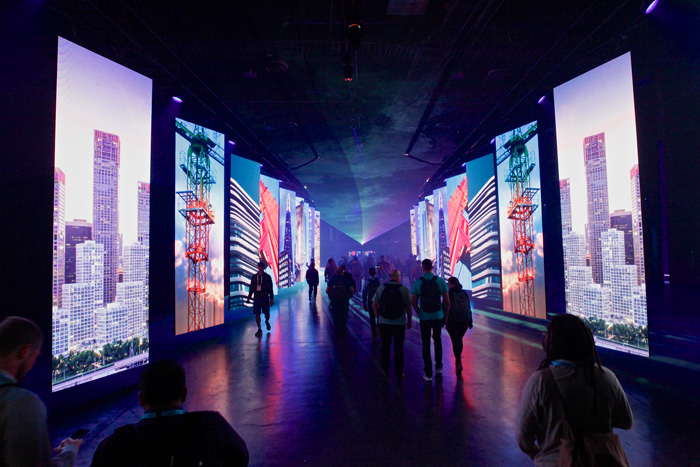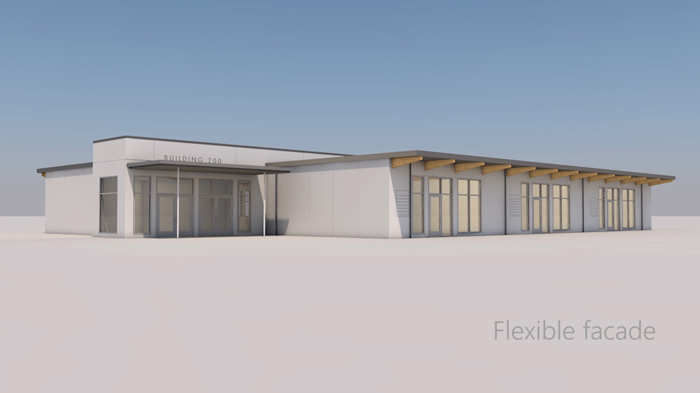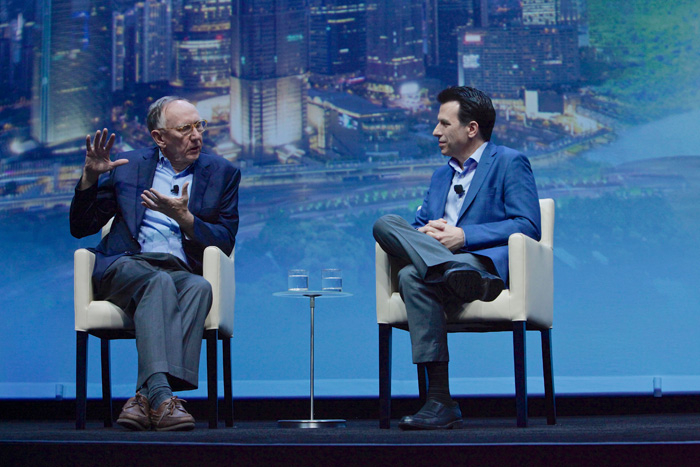At the first Autodesk University in Las Vegas under new CEO Andrew Anagnost, delegates got a taste of the company’s vision and focus for its current and next generation of products. Martyn Day of AEC Magazine attended the event
Autodesk University in Las Vegas is probably the biggest CAD event of the year, attended by over 10,000 customers, developers and resellers and hosted in one of Las Vegas’s vast casino hotels. The four-day event offers classes from key Autodesk staff, as well as high-level product experts, along with selected keynotes from the Autodesk top brass and its most innovative customers.
Former CEO Carl Bass generated an explosion of development at the company, firmly switching it from a reliance on 2D products to a range of 3D tools, 3D printers, cloud-based apps, high-end CNC machining, mobile applications, educational software, biotech and even social media.
Under Bass, the company also started its transition from charging customers traditional perpetual software licenses with added annual maintenance charges, to suites of subscription-based products.
Routes to market also started to change, with Autodesk selling more direct and relying less on its army of VARs (value added resellers). The company actively engaged with the resurgent ‘maker’ movement and established BUILD spaces for their activities at major offices (including San Francisco, Toronto, Boston and Portland).
After a run-in with investors who joined the board of the company, an agreement was reached in which Bass stepped down as CEO. A prolonged search for an external or internal replacement ensued, and in June 2017, Autodesk’s board gave the job to the company’s chief marketing officer and senior vice president of business strategy and marketing, Andrew Anagnost.
Anagnost is a 20-year Autodesk veteran who previously worked at NASA Ames Research Center. Under Bass, he served as architect and leader of Autodesk’s business model transition, moving the company to today’s softwareas- a-service (SaaS) model.
Unfortunately, in this reshuffle, Anagnost’s main competitor for the top job, Amar Hanspal, another long-term Autodesk employee and senior vice president of products (that is to say, the executive pretty much in charge of all product development), chose to leave the company.
With Autodesk currently in an income trough, a side-effect of moving from perpetual licence sales to subscriptions, Anagnost has not wasted much time in reorganising the company, adopting a ‘three horizons for innovation’ methodology. The first horizon (H1) is for incremental, successful products (AutoCAD, Inventor, Revit); H2 is for next-generation core businesses (Fusion, Forge); and H3 is for future growth engines (Machine Learning, Artificial Intelligence, Bio and so on).
The consequences of this new strategy have been profound. Many software developments that had failed to gain traction or that were costing more to deliver than they were bringing to the company in terms of revenue have been designated ‘end of life’. These include many iOS applications that are no longer developed, with the exception of Sketchbook Pro.
And, at the time of writing, the company has announced plans to cut some 13 percent of its workforce, or 1,150 jobs. Anagnost says that every penny saved from these lay-offs will be reinvested in the company’s digital infrastructure and construction focus.
For customers, one of the key benefits that they might see from the organisational changes underway is the removal of vertical market silos. For many years, Autodesk has tried to get its software suite to ‘speak the same language’, so that information can be shared seamlessly between each application. Industry silos inhibit these efforts, but a flat structure, combined with the cloud-based Forge back end could help Autodesk to finally achieve its unified data nirvana.
Anagnost’s keynote
This year’s Autodesk University was the first time Anagnost could publically deliver his vision of the future of design technology and the company’s key areas of focus for the next few years.
Previous keynotes from Autodesk CEOs have tended to look much further out into the realms of science fiction, rather than on near-term deliverables. Anagnost, in contrast, gave an insightful address on the benefits that automation will bring to society and on how it will change jobs and the nature of work. While many people are concerned about robots in the workplace and the prospect of Artificial Intelligence replacing knowledge jobs, Anagnost pointed to data from past revolutions, which without exception, led to the creation of new jobs. In the case of the digital revolution, for example, the introduction of the PC was seen as a threat to secretaries, but the reality was that personal processing power made many new jobs possible.
Anagnost argued that robotics and Machine Learning (a branch of Artificial Intelligence) should not be feared, but instead embraced. At the same time, however, the existing workforce should look to re-educate and upskill, in order to make the most of this opportunity.
In the field of design, Autodesk is leading this AI charge, with projects like Dreamcatcher and generative tools like Dynamo, which help engineers and designers create high-quality designs, guaranteed to meet customer needs every time. In other words, AI-powered design tools hold out the promise of enabling design teams to create more designs in less time.
In the past, Autodesk has tended to focus on the manufacturing space, with the development of products like Fusion. But Anagnost stressed that he has an expanded view of where Autodesk should be focusing next. In some ways, linking the past vision of manufacturing with a future vision of digital construction, where the company’s AEC tools are heading, could drive the next generation of building through digital fabrication. This is a much more balanced view for a company that has its eyes on so many markets. As a result, attendees from the construction space were given a lot more food for thought than in previous years.
Never one to mince his words, Anagnost told AutoCAD LT users that they should not bet the future of their company on 2D. The message was clear: if they do, they are betting on the wrong thing. Instead, he urged customers to explore the value that comes with products and services delivered on a subscription basis, rather than stick on perpetual licenses. That makes sense: Autodesk is now developing new machine learning functionality that can only be accessed via the cloud. Older products, now taken off maintenance, will not benefit from new functions like this.
#

Project Quantum & Forge
For those who have followed our articles on Autodesk’s Project Quantum closely, this year’s Autodesk University may have come as something of a disappointment. Quantum was only mentioned once and only then to say that it would be included in BIM 360. It turns out that by mentioning Quantum and ‘productifying’ the term, Autodesk became sensitive that it was creating demand for an application that was never intended. Quantum is, in fact, a range of services that will be added to Forge and BIM 360, with some of the underlying collaboration capabilities being made available to other Autodesk products. AEC Magazine hopes to bring you more information on what has become of Quantum and the technologies we have written about in the not-too-distant future.
When it comes to Forge, much time and effort at Autodesk has been spent, with little to show. This year’s Autodesk University, by contrast, was dramatic in terms of the number of application developers who had embraced the Forge environment. In the past, Autodesk developed products such as AutoCAD, with APIs (application programming interfaces) that developers would use to access data created in these programs to perform tasks such as rendering, document management, symbol libraries, raster-tovector conversion and so on. With each application, we had a different API that required the presence of the software to operate. Additionally, if you really wanted to create a complete, tailored application, you would have to license the underlying application (the original versions), which was very expensive.
Forge is a total rethink of this. Key components that are common to Autodesk’s applications have been written as services, which sit on the cloud backbone. These would include DWG, rendering, document management, analysis tools, import export, data translation, reality capture, 3D print optimisation, generative design and so on.
Through APIs, these underlying services become accessible to developers, who can mix and match them to quickly create bespoke applications with complete file fidelity and easy expansion not only to Autodesk services, but also through webhooks to other services, such as Dropbox. These capabilities are also open to Autodesk customers, who can develop applications for their own bespoke solutions.
Autodesk continues to flesh out Forge’s capabilities. In March 2018, the company will add a range of ‘IO’ capabilities – AutoCAD IO, Revit IO, 3ds max IO. These are headless (interfaceless) cloud versions of desktop applications and will enable developers to access, edit and create entities in models and drawings that are stored on Autodesk’s cloud services. The promise is that this will fundamentally change the way that thirdparty applications work, relying less on desktop applications and more on data and where it resides. It is an additional incentive for customers to move to cloud products, such as BIM 360, where storing data in the cloud can open up new possibilities to leverage model analysis and machine learning.
That doesn’t mean that desktop applications are going away. Authoring tools will still be required but, over time, there will be more benefits to storing project data on the cloud for collaborative workflows.
Forge Fund invests in construction
To help developers get on board and start working in the Forge environment, Autodesk previously announced a multimillion dollar fund. The lion’s share of this, however, went towards the manufacturing space. With the new focus on construction, Autodesk has systematically invested in a number of start-ups this year, including SmartVid.io, ManufactOn and Project Frog.
At Autodesk University, the company announced the fourth investment in five months, by leading the funding round for Assemble Systems. This company provides a SaaS platform that consumes BIM models, drawings and point clouds, enabling construction professionals to condition, query and connect the data to key workflows.
Tools cover bid management, estimates, project management, scheduling and finance, in view of the way that adoption of BIM and cloud technologies continues to accelerate across the construction industry. Assemble Systems will integrate its technology with Forge and will strengthen BIM 360’s pre-construction data management, quantification, estimation and other associated workflows.
Assemble extracts and federates models from Revit and AutoCAD and other design systems into projects. This enables the customer to group, sort and filter data into usable construction packages, to be used for quantification, estimating, shared subcontractor views and other workflows. As design models change, Assemble checks for those changes and reports on the impact to the project quantity, cost and schedule.

ESRI partnership
On stage at Autodesk University, Autodesk and ESRI announced a new strategic alliance to advance infrastructure planning and design. This partnership will build the bridge between BIM and GIS mapping technologies. Combining their technologies, Autodesk and ESRI are looking to enable a broad range of industries to gain better context by visualizing data of the man-made world, the environment, its residents and the networks that weave these all together.
Esri is a major supplier of geographic information system (GIS) software, with an estimated 43% share of the global market. It is headquartered in Redlands, California, with annual sales of some $1.1 billion.
This partnership will result in the integration of Autodesk and ESRI technologies, allowing industry professionals to synthesise information from both BIM and GIS, to enable a more connected infrastructure.
Benefits will include reductions in permissions, through improved stakeholder engagement; more sustainable and resilient design, through enhanced project insight; and reduced risk, through improved end-to-end flow of materials, resource availability and scheduling during construction.
Conclusion
Autodesk may appear to be a company in flux. Anagnost is making radical changes, while it simultaneously goes through a subscription-related trough, as well as lay-offs, and aims for a 50/50 direct sales/reseller model.
At the same time, the company needs to keep an eye on delivering value for the subscription money on which it now relies. This year’s decision to add even more products to its subscription collections, while welcome, does not necessarily mean that customers will derive any extra value from their participation. In our interview with Anagnost back in June, he acknowledged that there were ongoing issues and asked for a year to really deliver on subscription value for existing customers.
By getting rid of its silos, the com pany now better resembles the flat structure of its new, cloud-based applications. Hopefully, it will finally get interoperability nailed and its collections will s tart to work more like products in the Adobe Creative suite. Meanwhile, Forge is now starting to make more sense and deliver on some of the promises that the move to the cloud could bring. On the exhibition show floor at the event, a number of developers were showcasing Forgebased applications, giving an idea of the type of capabilities we can expect in future. We suspect this will bring a renaissance to Autodesk’s developer network and, with some very visual dragand- drop tools in development, could open up customisation to a new generation of users.
In the second part of this report, we look at core developments within Autodesk BIM360 and analyse the AEC keynote at Autodesk University, which provided insight into the company’s future vision for constr uction with digital fabrication.
If you enjoyed this article, subscribe to AEC Magazine for FREE






